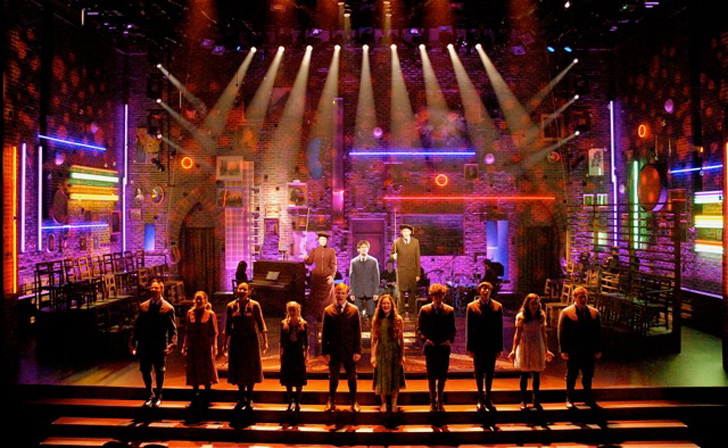Scenic Designers' Roundtable: The Art of Design
 David Gallo |
David Gallo |  October 10, 2012
October 10, 2012 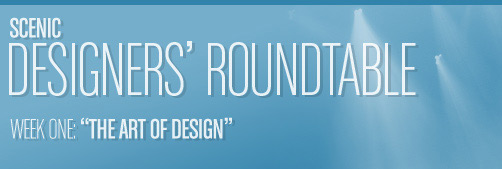 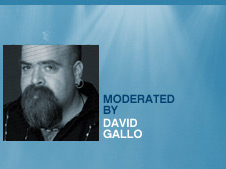 |
||||||
 |
||||||
Over the course of four weeks, scenic designer David Gallo will pose one question each week to a group of some of the top designers working in theatre and entertainment today. The hope is to scratch beneath the surface to glean some insights into these working artists’ artistic processes.
When David Mitchell was asked whether or not he defined himself as an artist, he replied, “To earn a living in this business—in order to survive—you must do a great variety of things. I don’t feel I have the luxury of taking a philosophical stance. Although I take what I do very seriously. Basically, it’s an interpretive and derivative art rather than a truly original or seminal one.” Do you have a personal philosophy on the “art” of being a scenic designer? - David Gallo, Performing Arts / Design Contributing Editor |
||||||
|
|
|
|||||
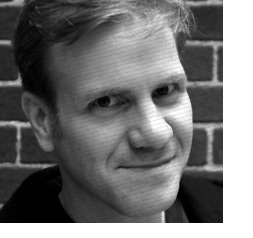
Unlike other so-called “seminal artists,” a scenic designer is working in the service of a collective goal and that always has to be a good story well told. This is not to diminish the role of the scenic, or other visual designers; the art of scenic design is the art of illusion. Even the most naturalistic approach, if done correctly, is transformative and allows the viewer to exist in and believe in the life of the words and the players who speak them in a way that is visceral and powerful. An “original artist” has the luxury of making up his or her own mind about what idea or feeling they are interested in exploring and in what medium. As a set designer, this choice comes from the commission and so there is intrinsically a distance between the work and the heart; but to be able to successfully apply your personal intellect, craft, and visual poetry within the boundary of the space, the budget, and the delicate balance of collaboration, is truly a special kind of skill that is something beyond a business or a science. Scenic design may be a derivative form, but it takes an artist to practice it. |
||||||
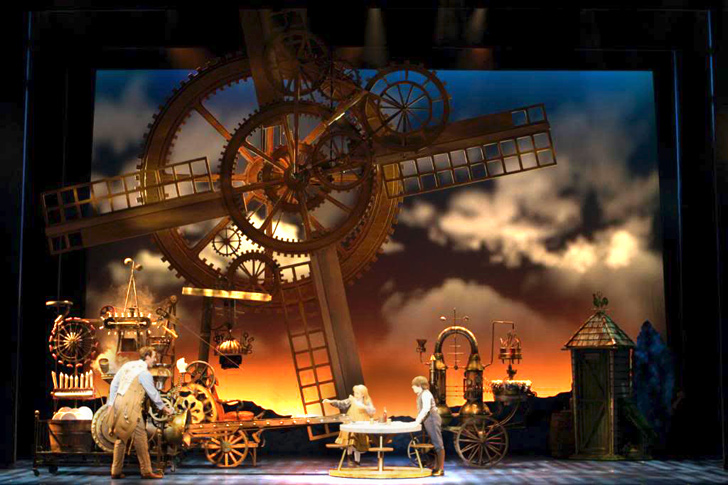 |
 |
|||||
| (Chitty Chitty Bang Bang) | (Pirates!) | |||||
 |
||||||
| (Lucky Guy) | ||||||
 |
||||||
| (City Club) | ||||||
|
|
|
|||||
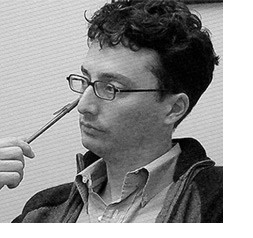
I don’t think of scenic design as an art in and of itself separate from a production as a whole. If I design a wonderful set for a terrible production, it’s disappointing. I guess if I design a terrible set for a wonderful production, that’s also disappointing. Stage design is part of theatre as an art. That said, an awful lot of the projects I do probably don’t rise to the level of art, meaning I don’t think they’ll be remembered or discussed a hundred years from now. But, if I’m lucky, occasionally I get to work on a piece that I think will last, and I like that I’ve made a contribution to that. I think that in those small ways I get to brush up against something larger than the here and now, and those moments are terribly exciting. |
||||||
 |
||||||
| (Chaplin) | ||||||
 |
||||||
| (Sondheim on Sondheim) | ||||||
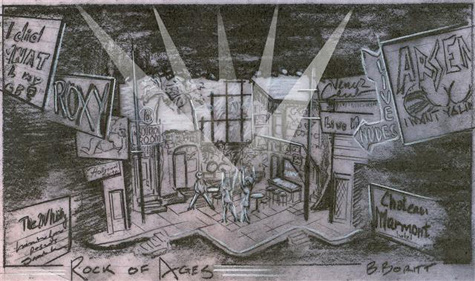 |
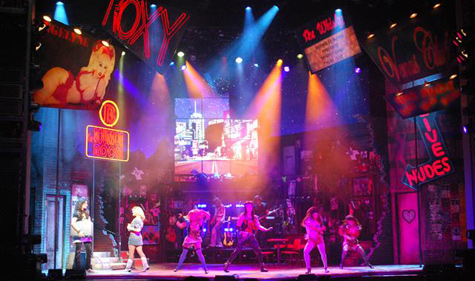 |
|||||
| (Rock of Ages - rendering) | (Rock of Ages) | |||||
|
|
|
|||||
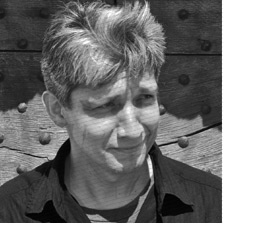
I believe in finding the visual essence of any given specific opera, play, dance or musical. My aim is to discover and articulate a “place” that can only exist in performance-time, suggestive and non-imitative. Poetic rather than specific. An interesting contradiction: Not a “set,” but as Strindberg already said: a space “Where anything can happen, everything is possible and probable. Time and place do not exist.” A space where text becomes alive and is not hindered by illustration. A space that creates its own logic, and lets us dream. A space that allows us to transcend our daily routines, and where the stage is an infinite place of possibility, specially today when our lives are so encumbered by an ailing economic system and a political cynicism that burdens us all with deep mistrust. Today’s great theater artists keep luring us back to this seminal performance/audience connection with barely nothing at their disposal: Ariane Mnouchkine, Romeo Castelluci, Angelica Liddell, Robert Woodruff, Arthur Nauzyciel… Or in film, who can ever forget the blank stares of Joan of Arc in Dreyer’s masterpiece, or Erland Josephson’s prayer looking straight into the camera in Andrei Tarkovky’s The Sacrifice, and Bresson’s enigmatic Au Hasard Balthazar… Theatrical space allows you/audience to surrender and to embrace another kind of reality, and because of this phenomenon, I believe the ”set” cannot be a lie/gimmick or illustrative illusion, a fake, but a bridge to your imagination. This is where theater’s magic trance exists, and only in live performance. I deeply believe that removing all that’s not necessary is key. Trust in simplicity. As I get older and no longer feel the need to blow people away with “theatrical” trickery and a plethora of moving scenic elements that I find clunky and predictable, I always return to the fact that less is more. But it is how you articulate this simplicity that is so hard and so elusive… At the end of the day it is what keeps me going, what keeps me searching, it is what gives meaning to my craft and with what I can hopefully touch and move the audience. I am baffled when today’s theater critics say they are confused because the “set-designer” has not been “specific” enough about portraying “location.” The theater of Shakespeare relied on NO scenery; Ingmar Bergman’s Long Day’s Journey Into Night dispensed with O’Neil’s iconic home and turned it into a ritualistic platform, no walls. In a beautiful passage of The Dramatic Imagination, Robert Edmond Jones quotes Walt Whitman: “I seek less, to display any theme or thought and more to bring you into the atmosphere of the theme or thought—there to pursue your own flight.” |
||||||
 |
||||||
| (Desire Under the Elms) | ||||||
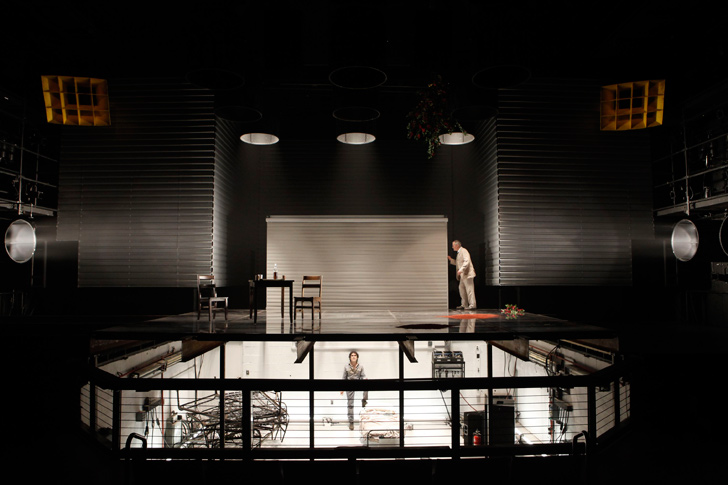 |
 |
|||||
| (Battle of Black and Dogs) | (Lost Highway) | |||||
 |
||||||
| (Appomattox) | ||||||
|
|
|
|||||
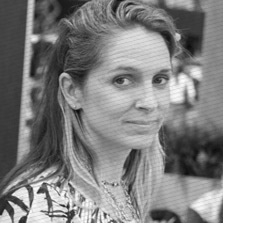
Whether one is an artist or not depends more on how you do what you do, than what you do. I recently read Jonathan Lethem’s essay, “The Ecstasy of Influence,” which I highly recommend. After reading it one might argue that all art is interpretive or derivative. Designing is a collaborative art form. You collaborate with the text, the author, (dead or alive), the director, other designers, craftsmen, history, color, all kinds of materials… You can put all of that together like a chef, or like a short order cook—it’s how you do it, not what you do that defines what the result is… it’s a practice. |
||||||
| (Spring Awakening) | ||||||
 |
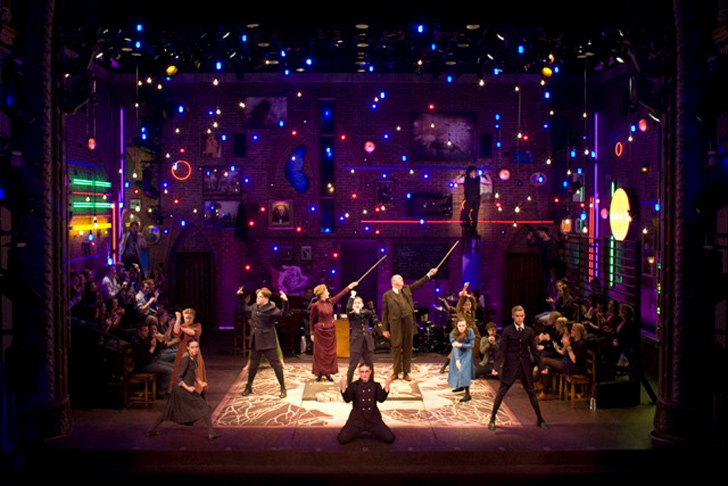 |
|||||
| (Spring Awakening) | (Spring Awakening) | |||||
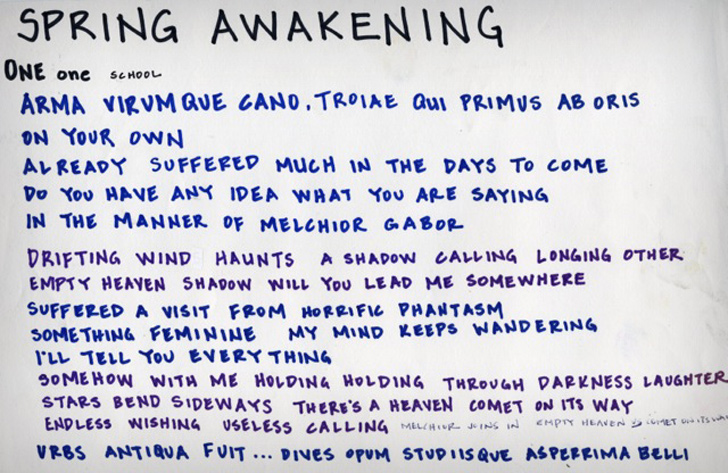 |
||||||
| (Spring Awakening) | ||||||
|
|
|
|||||

As a theatre designer I am a collaborative artist. As such, my ultimate goal is to be an integral and valuable part of a shared living vision that morphs and changes with every performance as experienced by the audience. Any cog of the creative machine is dependent, and fueled by, the others—writer, composer, director, choreographer, partner designers, builders, painters, craftspeople, and ultimately performers. Each of us has an “art” form and responsibility to achieve our part but none are singular when making the whole. I have many skills that are typically defined as “artist”—drawing, painting, sculpture, etc., however; I can design for the theatre without using any of them. Ultimately my art is a marriage of vision and intent with practicality and ability and to always reach higher than I could on my own. |
||||||
 |
||||||
| (Anna Karenina) | ||||||
 |
||||||
| (Dead Man’s Cell Phone - renderings) | ||||||
 |
||||||
| (Dead Man’s Cell Phone) | ||||||
|
|
|
|||||
|
||||||
|
ROB BISSINGER has designed for the theatre for over 10 years and his work has been seen regionally in Damn Yankees, Meet Me in St. Louis, The Full Monty (Paper Mill), Half A’ Sixpence, Pirates! (Goodspeed), Hunter/Gatherers (the Wellfleet Harbor Actor’s Theatre), and Everything’s Ducky at the St. Louis Rep, for which he received a Garland Award. Off-Broadway credits include: Lucky Guy (Little Shubert), City Club (Minetta Lane), and Jacques Brel is Alive and Well and Living in Paris (The Zipper). In addition to art directing large-scale projects like the Venetian Phantom Theatre in Las Vegas, he has also been associate designer for Broadway productions including Spider-man: Turn Off the Dark, and his designs have appeared all over the world in 3 Mo’ Tenors, Chitty Chitty Bang Bang, Scooby Doo in Stagefright, Disney’s Believe, and most recently, Mythbusters: Behind the Myths. |
||||||
|
BEOWULF BORITT Broadway: The Scottsboro Boys (Tony Nomination), Rock of Ages, Chaplin, Grace, Sondheim on Sondheim, …Spelling Bee, Lovemusik, The Two and Only. Off- Broadway: More than 50 shows including The Last Five Years, Toxic Avenger, If There Is I Haven’t Found It Yet, Miss Julie, Public, Roundabout, MTC, 2nd Stage, Vineyard, MCC, New Group, Pearl, American Place, Keen Company. Other Designs: The Seven Deadly Sins (New York City Ballet), Paradise Found (London), Reel to Real (Beijing) and 2 editions of the Ringling Brothers and Barnum & Bailey Circus. He received a 2007 OBIE Award for sustained excellence in set design. |
||||||
|
RICCARDO HERNANDEZ Broadway: The Gershwins’ Porgy and Bess (2012 Tony Best Musical Revival), The People in the Picture (Studio 54), Tony Kushner’s Caroline, or Change (also National Theater, London), TopDog/UnderDog (also Royal Court, London), Elaine Stritch at Liberty (also West End’s Old Vic & National Tour), Parade (Tony and Drama Desk Nominations), Bells Are Ringing, Bring in ‘Da Noise, Bring in ‘Da Funk (also National Tours and Japan), The Tempest. Recent: La Mouette (Cour D’Honneur, Avignon Festival), Jan Karski, Mon Nom Est Fiction (Opera Theatre, Avignon Festival), Abigail’s Party (Oslo National Theater), Philip Glass’ Appomatox (Robert Woodruff director, San Francisco Opera), The Lost Highway (London’s English National Opera/Young Vic), Die Entfuhrung Aus Dem Serail (Opera de Nice, France), Il Postino (Los Angeles Opera, Opera de Chatelet Paris, Theater an der Wien), David Adjmi’s Marie Antoinette (American Repertory Theater). Over twenty productions at New York Shakespeare Festival/Public Theater: The America Play, One Flea Spare, Stuff Happens, Mother Courage, etc), BAM, Lincoln Center, Atlantic, Second Stage, NYTW, MTC, MCC, Playwrights Horizons, etc. Regional: American Repertory Theater, Guthrie, Goodman, Taper, La Jolla, Steppenwolf, McCarter, etc. Opera: Amistad (Opera of Chicago), Houston Grand Opera, Charles Wuorinen’s Haroun (New York City Opera), Sweeney Todd (Opera Theater of Saint Louis. Also: Festival Automne Paris, Orleans CDN France, Det Norske Teatret Oslo Norway, MXAT Moscow. Upcoming: Frank McGuinness’ adaptation of The Dead directed by Joe Dowling for the Abbey Theater, Dublin. Princess Grace Statue Award. |
||||||
|
CHRISTINE JONES is a freelance set designer and the Artistic Director of the critically acclaimed Theatre for One, a portable private performing arts space for one actor and one audience member. She won a Tony Award for her work on American Idiot, A Punk Rock Musical directed by Michael Mayer, with whom she will be making her debut at The Metropolitan Opera with their production of Rigoletto. Additional Broadway credits include: On a Clear Day, Spring Awakening (Tony Nomination), Everyday Rapture, (all directed by Mayer), and The Green Bird, directed by Julie Taymor. Currently she is designing Hands on a Hardbody, a new musical based on the cult documentary film. Additional credits include: The Book of Longing, based on the poems of Leonard Cohen with music by Philip Glass (Lincoln Center Festival), The Onion Cellar (Elliot Norton Award), which she co-created along with director Marcus Stern and The Dresden Dolls, Much Ado About Nothing (Shakespeare in the Park), and Burn This starring Ed Norton and Catherine Keener (Signature Theatre). Her designs were included in the exhibition Curtain Call: Celebrating a Century of Women Designers for Live Performance at Lincoln Center Library for Performing Arts (2008). For achievements in her field, she received an Award of Distinction from Montreal’s Concordia University, 2009, and was honored at NYU’s Tisch Gala 2007. She has lectured at Princeton University and is currently Adjunct Faculty at the Tisch School of the Arts. |
||||||
|
G. W. (SKIP) MERCIER is a set, puppet, and costume designer who began professional work in 1983 and has since designed over 350 shows. He graduated Phi Beta Kappa with a BA in Dramatic Art from the University of California at Berkeley and the Yale School of Drama with an MFA where he was named the Oenslagger Scholar for the founder of the design program. Dozens of New York premieres include Dead Man’s Cell Phone by Sarah Ruhl at Playwright’s Horizons directed by Anne Bogart, Urban Zulu Mambo with Regina Taylor for Signature Theatre, Miracle Brothers by Kirsten Childs directed by Tina Landau, Eli’s Comin’, the work of Laura Nyro, and True History and Real Adventures by Sybill Pearson, with music by Mel Marvin and directed by Michael Mayer, both at The Vineyard Theatre, where he is a resident artist. He is currently working on a world premiere of the yet-to-be-titled show by Bill Irwin, David Shiner, and Nellie McKay, directed by Tina Landau for Signature Theatre, Alice in Wonderland, directed by Peter Brosius for Children’s Theatre in Minneapolis, and an adaption of Peter And The Wolf with Doug Fitch to be co-produced by Giants are Small and Cirque du Soleil. |
||||||












